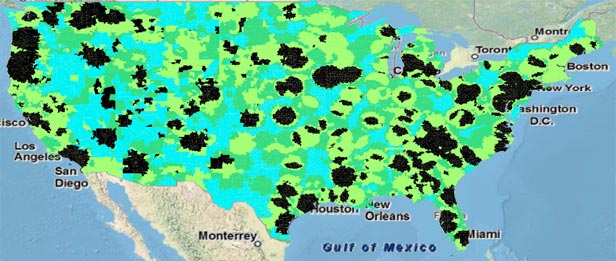Will super Wi-Fi live up to its name?
September 23, 2011 | Source: Technology Review

White spaces (empty frequencies in the spectrum), some blacked out by the FCC, could enable long-range "Super Wi-Fi" (credit: Spectrum Bridge)
It’s likely that a few years from now, Americans’ laptops, smart phones, and other wireless devices will be able to get online using “Super Wi-Fi,” a new standard that will increase capacity in places where regular Wi-Fi networks have become overcrowded. The idea of Super Wi-Fi is to make use of the vacant airwaves that lie between existing TV stations’ frequencies, gaps known as white spaces.
A new model for managing America’s airwaves was unveiled Monday, as part of a plan by Federal Communications Commission chairman Julius Genachowski to ease what he calls America’s “spectrum crisis.”
The bad news: most people won’t be able to use those airwaves to make long-range connections, which was supposed to be the major technological advance that would put the “super” in Super Wi-Fi. As a result of government rules designed to protect local TV stations from harmful interference, while there are 48 channels potentially available for long-range Super Wi-Fi, zero or one channel will be available for long-range use in the places most Americans live — so Super Wi-Fi networks significantly bigger than today’s home Wi-Fi networks won’t be practical.
Ultimately, Congress could decide to loosen the limits on Super Wi-Fi — over the objections of TV broadcasters.
